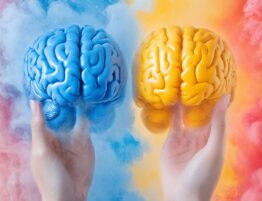People perceive pain differently. Everyone has an individual threshold of sensitivity. Individuals with nerve damage often have inherently impaired natural pain suppression mechanisms. They experience greater discomfort from pain impulses. Scientists have found that the use of virtual reality (VR) produces remarkable results. This technology can reduce pain in patients with nerve damage. VR also restores the function of the pain suppression system. This can significantly improve the healing of patients with chronic pain syndromes. The latest technology can reduce pain perception itself. The method is changing how chronic pain is typically managed.
VR significantly improves all processes. It personalizes therapy plans for optimal results. This approach improves cognitive function and coordination. It boosts confidence. This feature makes VR an indispensable tool in modern rehabilitation. Such technology continues to advance. Its integration into therapy programs will redefine the medical field. VR provides patients a more effective and rewarding recovery process.
Virtual Reality: A Game-Changer in Neurological Therapy
Integrating VR into neurological rehabilitation revolutionizes therapy by enhancing motor skill recovery and improving patient outcomes through an immersive and interactive environment. This technology accelerates recovery through engaging and task-oriented exercises. What makes VR so revolutionary? Let’s explore:
- Boosting Neuroplasticity: VR-based exercises stimulate brain reorganization. They encourage the development of new neural pathways crucial for motor function restoration.
- Increasing Patient Engagement: Traditional therapy can be monotonous. VR gamifies recovery. It makes exercises more enjoyable and motivating for patients.
- Enhancing Motor Skill Recovery: Virtual reality provides real-time feedback. It helps patients refine movements and improve coordination. VR helps patients regain strength through repetitive and interactive tasks.
- Customizing Therapy for Individual Needs: VR programs adapt to a patient’s progress. They adjust difficulty levels and offer personalized treatment plans.
- Simulating Real-World Activities: VR allows patients to practice daily tasks. This is possible in a safe and controlled environment, such as walking, reaching, or gripping.
- Providing Data-Driven Insights: Therapists can track real-time performance metrics. They refine therapy strategies based on objective progress data.
Neurological rehabilitation augments traditional techniques with VR. It becomes more effective, engaging, and patient-centered. This method ultimately leads to faster and more sustainable recovery.
Enhancing Motor Recovery with Virtual Reality
VR engages patients in interactive, task-based exercises. They stimulate neuroplasticity and rebuild muscle strength. Some individuals are recovering from strokes, spinal cord injuries, or neurodegenerative diseases. VR offers a highly effective and motivating rehabilitation tool. There are key benefits for motor recovery:
- Retraining Neural Pathways: VR-based therapy stimulates neuroplasticity. It encourages the brain to form new connections that restore lost motor functions.
- Improving Muscle Strength and Coordination: Virtual exercises activate underused muscles. They enhance movement control and endurance through targeted, repetitive activities.
- Enhancing Balance and Gait Training: VR enables patients to practice walking and weight-shifting. It lets them experience coordination exercises in a controlled virtual environment.
- Providing Real-Time Feedback: Patients receive instant feedback on movement quality, helping them adjust and improve performance.
- Increasing Therapy Engagement and Adherence: The gamified nature of VR makes rehabilitation enjoyable. It motivates patients to stay consistent with their therapy.
There are case studies and research on virtual reality’s effectiveness. Let’s explore:
- Stroke Rehabilitation: A study in Neurorehabilitation and Neural Repair found that stroke patients experienced more significant improvements in hand and arm function compared to traditional therapy.
- Parkinson’s Disease: Research in Frontiers in Neurology demonstrated VR-based balance training. It helps reduce fall risk and enhances mobility in Parkinson’s patients.
- Spinal Cord Injury: VR-supported rehabilitation helps restore lower limb movement and walking ability. It promotes active participation in therapy.
Integrating VR into rehabilitation programs is crucial. Patients experience a more engaging and practical approach to motor recovery. It leads to faster and more sustainable improvements in mobility and strength.
How Virtual Reality Boosts Patient Engagement in Rehabilitation
One of the biggest challenges in rehabilitation is maintaining patient engagement. Traditional therapy can often feel repetitive and discouraging. VR changes this dynamic by offering an interactive, immersive experience. It keeps patients motivated and actively involved in their recovery. How VR enhances patient engagement:
- Creating an Immersive Therapy Experience: VR transports patients into engaging virtual environments. It makes exercises feel more like a game rather than routine therapy.
- Boosting Motivation with Gamification: Rewards, progress tracking, and interactive challenges encourage patients. It lets them push their limits and stay committed to their rehabilitation.
- Reducing Therapy-Related Stress and Anxiety: VR makes rehabilitation less intimidating by providing a safe, controlled space where patients can practice movements at their own pace.
- Personalizing Treatment to Suit Individual Needs: Virtual reality programs adapt to patients’ abilities. They adjust difficulty levels to ensure a challenging yet achievable rehabilitation process.
- Providing Real-Time Feedback for Improvement: Instant feedback helps patients understand their progress. It makes necessary adjustments to enhance recovery.
- Encouraging Longer Therapy Sessions: The engaging nature of VR keeps patients focused. It often leads to extended therapy sessions and better overall outcomes.
- Simulating Real-World Scenarios for Functional Recovery: Patients can practice daily activities, such as walking or reaching in a controlled virtual space. VR improves their confidence and independence.
By integrating VR into rehabilitation, patient engagement increases significantly. It leads to a more enjoyable, effective, and sustained recovery process.
Therapy Techniques of the Future: Virtual Reality in Action
Advancements in rehabilitation are reshaping recovery through innovative techniques. These techniques are generally powered by VR. Immersing patients in interactive environments enables targeted therapy approaches. They accelerate motor recovery, improve cognitive function, and enhance overall rehabilitation outcomes. Here are the main techniques:
- Task-Specific Training for Motor Recovery: Patients perform repetitive, goal-oriented movements. They retrain motor pathways. VR improves coordination and strength.
- Immersive Simulations for Real-World Skill Practice: VR replicates daily activities such as walking, reaching, and gripping. It allows patients to regain lost abilities in a safe environment.
- Balance and Gait Training for Mobility Improvement: VR-based exercises help patients practice stability, weight shifting, and walking mechanics.
- Hand and Arm Rehabilitation: Interactive tasks include virtual object manipulation. These therapy techniques improve dexterity and hand-eye coordination.
- Cognitive Training for Neurological Recovery: Memory, attention, and problem-solving exercises support cognitive rehabilitation for stroke and traumatic brain injury.
- Pain Management and Sensory Retraining: VR distracts from discomfort. It stimulates sensory pathways, aiding patients with neuropathic pain or sensory deficits.
- Customizable Therapy Programs for Individual Needs: VR platforms adjust difficulty levels and exercises. They are customized based on a patient’s progress and specific neurological condition.
Therapy techniques with VR offer a highly personalized, engaging, and practical approach. It restores lost abilities and improves patient outcomes by integrating cutting-edge therapy techniques.
The Role of Virtual Reality in Treating Common Neurological Conditions
VR transforms rehabilitation by providing targeted therapy for conditions like stroke, Parkinson’s disease, and traumatic brain injury (TBI). VR helps patients regain motor function through interactive exercises, real-time feedback, and immersive simulations. VR improves cognitive skills and enhances motor recovery. How does VR support rehabilitation for specific conditions? Let’s explore:
- Stroke Rehabilitation: VR encourages neuroplasticity by retraining the brain to form new connections. It improves motor recovery through repetitive, task-oriented exercises. VR enhances hand function and coordination. It simulates gripping and reaching.
- Parkinson’s Disease Therapy: Aids balance and gait training. This method creates controlled environments for safe movement practice. Virtual reality reduces freezing episodes with visual and auditory cues. They guide smooth movements. VR improves reaction time and coordination through interactive exercises.
- TBI Recovery: VR supports cognitive rehabilitation through memory, attention, and problem-solving exercises. VR enhances motor function and strength through engaging, goal-driven therapy. It reduces anxiety and stress by providing a low-pressure rehabilitation setting.
Integrating VR into therapy techniques helps patients experience a more engaging and personalized recovery process. It leads to improved independence and quality of life.
Why Virtual Reality Is the Future of Neurological Rehabilitation
VR is set to revolutionize neurological rehabilitation. It makes recovery more effective, efficient, and accessible. VR therapy will expand its capabilities through continuous innovation. Virtual reality offers more personalized treatments and improved patient outcomes. Here are the upcoming trends and innovations:
- AI-Powered Adaptive Therapy: Future VR systems will use artificial intelligence to analyze patient performance in real time. AI adjusts exercises to match progress and optimize recovery.
- Expanded Tele-Rehabilitation Solutions: VR will enable remote therapy sessions. It allows patients in rural or underserved areas to access high-quality neurological rehabilitation. This can be done from the comfort of their own homes.
- Full-Body Motion Tracking: This is crucial for enhanced motor recovery. Advanced motion sensors and haptic feedback will improve movement precision. It makes rehabilitation exercises even more immersive and responsive.
- Integration with Brain-Computer Interfaces (BCIs): VR combined with BCIs helps patients with severe neurological conditions regain motor control. VR directly stimulates brain activity.
- VR-Based Cognitive and Emotional Therapy: Enhanced VR programs will support motor recovery. They help with cognitive rehabilitation for memory, attention, and emotional well-being.
- Real-World Simulation for Functional Independence: Future VR systems will replicate highly realistic environments. They help patients practice daily tasks. For example, cooking, driving, or walking in public spaces.
- Personalized Data-Driven Treatment Plans: Machine learning algorithms will track patient progress. They provide therapists with in-depth analytics that allow them to refine treatment strategies.
VR will continue to push the boundaries of neurological rehabilitation with such advancements. It makes therapy more customized and accessible worldwide. Recovery approaches will become more patient-centered by integrating these innovations. It leads to faster recovery and improved quality of life. Do you need help? Contact us. Our professional team will do everything for you.













Please, leave your review
Write a comment: